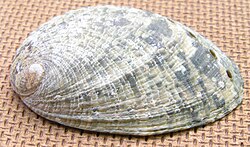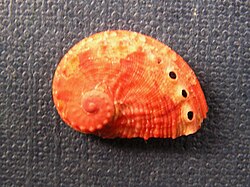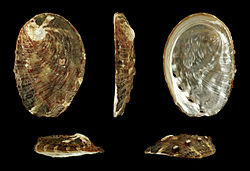Haliotis spadicea (blood-spotted abalone) (South Africa) 3 (24139744761)
Haliotis spadicea Donovan, 1808 - exterior surface of a blood-spotted abalone from South Africa (public display, Bailey-Matthews Shell Museum, Sanibel Island, Florida, USA).
The gastropods (snails & slugs) are a group of molluscs that occupy marine, freshwater, and terrestrial environments. Most gastropods have a calcareous external shell (the snails). Some lack a shell completely, or have reduced internal shells (the slugs & sea slugs & pteropods). Most members of the Gastropoda are marine. Most marine snails are herbivores (algae grazers) or predators/carnivores.
The abalones are an odd group of gastropods that have a coiled, cap-shaped, aragonite shell with a curvilinear set of excurrent respiratory holes. Interior shell surfaces have intensely iridescent nacreous aragonite ("mother of pearl"). Abalones are hard substrate algae grazers.
From museum signage [typos and mis-spellings corrected]: "Abalones are gastropod molluscs that typically have a widely open shell with holes. The holes serve to expel water after it circulates through the animal during breathing. Some abalones have very elegant shapes and striking colors and their beauty is boosted by the presence of a colorful layer of mother-of-pearl lining the interior of the shell."
"There are about 75 species of abalone. These species live on submerged rocks along different continents and islands, usually in cold water areas The West Coast of the U.S. is rich in abalone species. Abalones attach themselves to the rocks using a powerful shell muscle. They are herbivores, grazing on seaweed, with help from a set of specialized teeth called a radula."
The blood-spotted abalone shown above is part of the South African Province: "The huge waves and cool waters of South Africa have produced a molluscan fauna dominated along its rocky shores by large limpets and abalones. Its beaches are often strewn with colorful, offshore cones, trochids and volutes. At certain seasons the cast-off egg-cradles of three species of paper nautiluses are found abundant on some beaches." [info. from museum signage}
Classification: Animalia, Mollusca, Gastropoda, Haliotidae
Locality: unrecorded locality in South Africa
More info. at: en.wikipedia.org/wiki/Haliotis and
en.wikipedia.org/wiki/Haliotis_spadiceaRelevantní obrázky
Relevantní články
UšňovitíUšňovití (Haliotidae) je čeleď plžů. Jedná se o monotypickou čeleď, s jediným rodem ušeň (Haliotis). .. pokračovat ve čtení










































